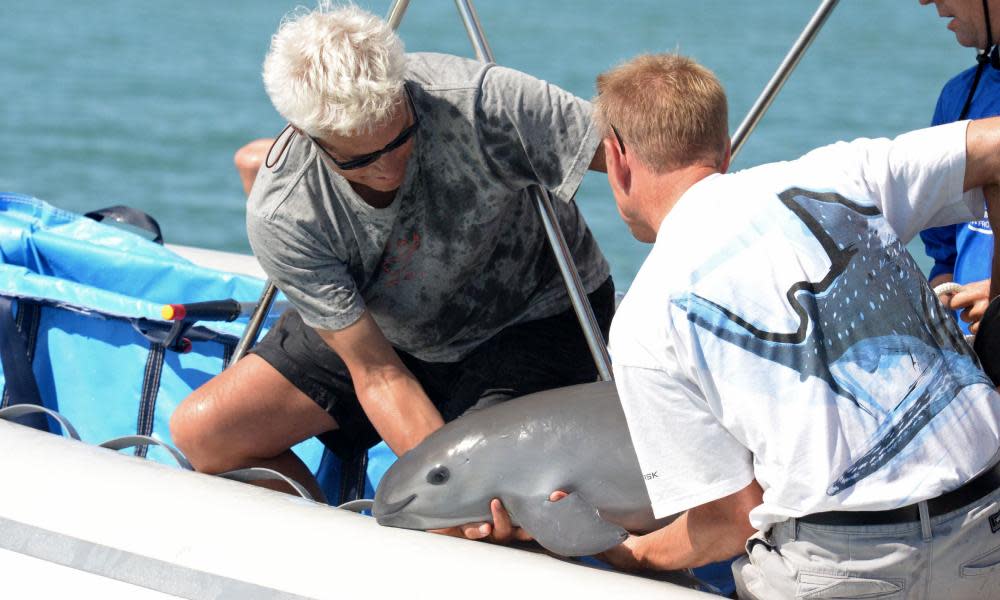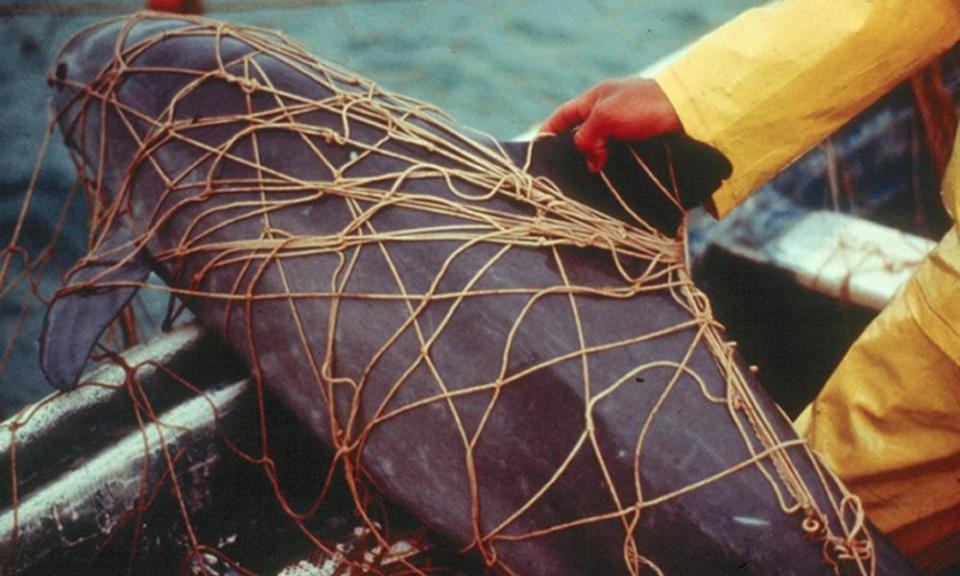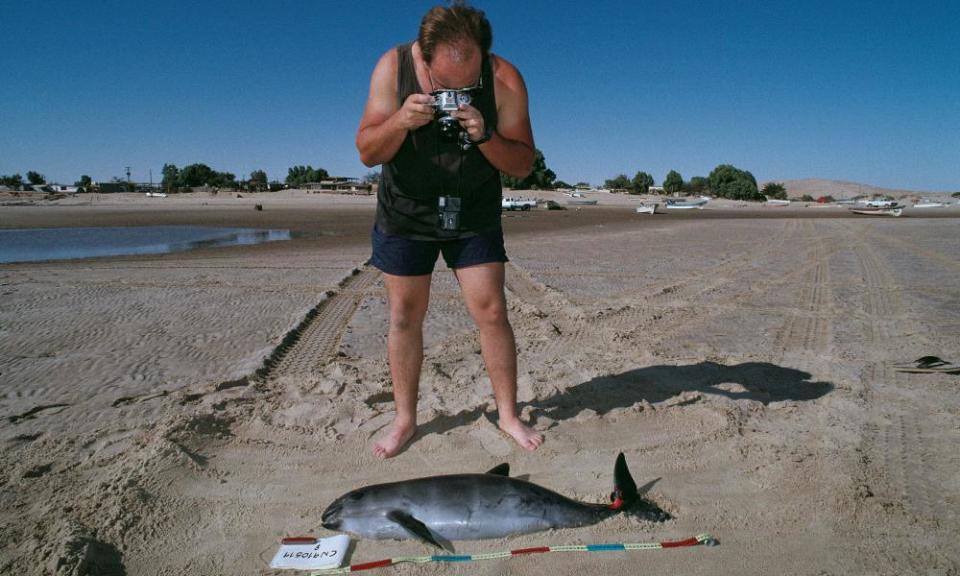There are fewer than 10 tiny vaquita porpoises left. Can they be saved?

The vaquita, the world’s tiniest marine mammal, has long teetered on the brink of extinction. The population of porpoises marked with black ringed eyes and smiling, upturned mouths has dwindled by a devastating 99% over the last decade.
Now scientists say their future is more precarious than ever, after a recent survey found fewer than 10 individuals left in the waters of their limited home range between Baja California and Mexico.
But some say there is still hope for the endangered species that has persisted against the odds.
“We are looking for a needle in the haystack – but we know the needle is there,” says Barbara Taylor, a marine conservation biologist for the National Oceanic and Atmospheric Administration, noting how researchers can still hear their high-pitched calls and echolocation clicks, collected on auditory monitoring equipment placed throughout their habitat. Taylor has tracked endangered species that have been pushed out of existence before and she’s determined to stop the small, shy, cetacean from joining that list.
The task won’t be easy. Vaquitas continue to face a host of threats, including a lucrative illegal fishing industry, political apathy and conservation measures that have been largely ineffective.
Dangers from the fishing industry
Vaquitas share the Gulf of California with highly coveted sea creatures including the totoaba, an endangered fish with perceived medicinal properties that retails in China’s black market for thousands of dollars. Vaquitas, alongside sea turtles and whales, can easily become entangled in the massive mesh netting known as “gillnets” used by totoaba poachers and local fishers.

The US has sought to put pressure on Mexico over the issue. On Thursday, the Office of the United States Trade Representative announced that it was requesting consultations with the Mexican government over whether environmental commitments made under the United States-Mexico-Canada Agreement – which replaced Nafta in 2020 – that were intended to protect vaquitas had fallen short.
The US has also enacted embargoes on the Mexican seafood industry, including banning importation of seafood typically caught in gillnets in vaquita territory. Last year, the US also stopped importing all Mexican wild-caught shrimp citing concerns over sea turtle protections.
The Mexican government has outlawed totoaba fishing and made the use of gillnets in the area illegal, but few of the promised penalties have been carried out. There have also been efforts made to compensate fishers who replace the dangerous gear but the funds were not equitably distributed, frustrating fishers who were left in the lurch.
Mexican president Andrés Manuel López Obrador, who oversaw a policy reversal and rolled back enforcement in the protected area has spoken out about sanctions against the Mexican seafood industry and international interventions.
Meanwhile, as enforcement from authorities waned, illegal fishing has flourished. Backed by the cartels, the expansion of the totoaba market has coincided with vaquita numbers dropping roughly 50% annually. International advocates have struggled to shift the tides.
“When we were out there the last three times it was gillnets everywhere,” Taylor says of survey trips that took place in 2018, 2019, and earlier this year.
Without strong consequences or enough compensation, there’s little motivation to change. Called the “cocaine of the sea”, totoaba prices far outpace anything fishers could make in above-board markets. Cartels have cashed in, further increasing the incentives to ignore the regulations. “There was no one that was trying to hide anything from us,” Taylor said.
Conservation versus the local economy
Even those who appreciate the danger vaquitas are in have raised questions about the value of protecting them at the expense of local livelihoods. Local economies and culture are closely entwined with fisheries in the vaquita range. Even before the totoaba market exploded, gillnets were used to catch blue shrimp and other species that dwell in the biodiverse waters.

“The government still hasn’t given us a solution or an effective way to support our families without going out to fish illegally,” Ramón Franco Díaz, president of a federation of fishing cooperatives in San Felipe, told the New York Times last autumn. “The children need food and clothes.”
“For many of the local community the vaquita is a nuisance that the sooner it goes extinct the better, because then they can poach unhampered,” said Vanda Felbab-Brown, a senior fellow in the Center for Security, Strategy, and Technology in the Foreign Policy program at Brookings. She noted that these issues have existed in the Gulf of California for decades, predating the spike in overseas demand for totoaba, and highlights the “enormous challenge” inherent in environmental conservation. “The issue of how to fund conservation - paying communities not to poach - is something that we are really going to be confronting at a greater scale,” she said.
Vaquitas have never been particularly abundant. They tend to produce calves only once every two years and it takes decades for them to mature and reproduce. But Felbab-Brown says that the absence of law enforcement in the area has only exacerbated the issue. “The sense is that anything goes,” she said. “Now in a situation where we have 7 or 8 vaquitas left.”
Related: Up to 48 species saved from extinction by conservation efforts, study finds
Without local support and enforcement, environmentalists say it will be even more difficult to pull the species back from the brink, especially now that time is running out.
“The reason it really is not working is there isn’t the governance to enforce another way of fishing and to support and compensate fishers who fish in a way that would allow vaquita to survive,” says Francis Gulland, Commissioner at the US Marine Mammal Commission, who added that working to get buy-in from the community is a far more effective strategy than attempting to enforce top-down bans. It’s a lesson she hopes can be learned in time to spare other species, which could soon also be subject to precipitous decline.
“We tend to not pay attention until we are in total crisis mode,” she says, noting that conservation efforts didn’t really start until there were just a few hundred vaquitas left. When the population fell further, advocates attempted to catch vaquitas to relocate them to protected areas, but the program was promptly stopped after it resulted in one vaquita’s death. “If there had been 10 thousand animals we would have time to learn what to do to improve the techniques,” Gulland said. “They could have been moved to a protected area but it was all too late.”
There is still time to save the vaquita, she says, but not much. “If we can prevent them from being caught in nets,” she says, “they will survive.”

